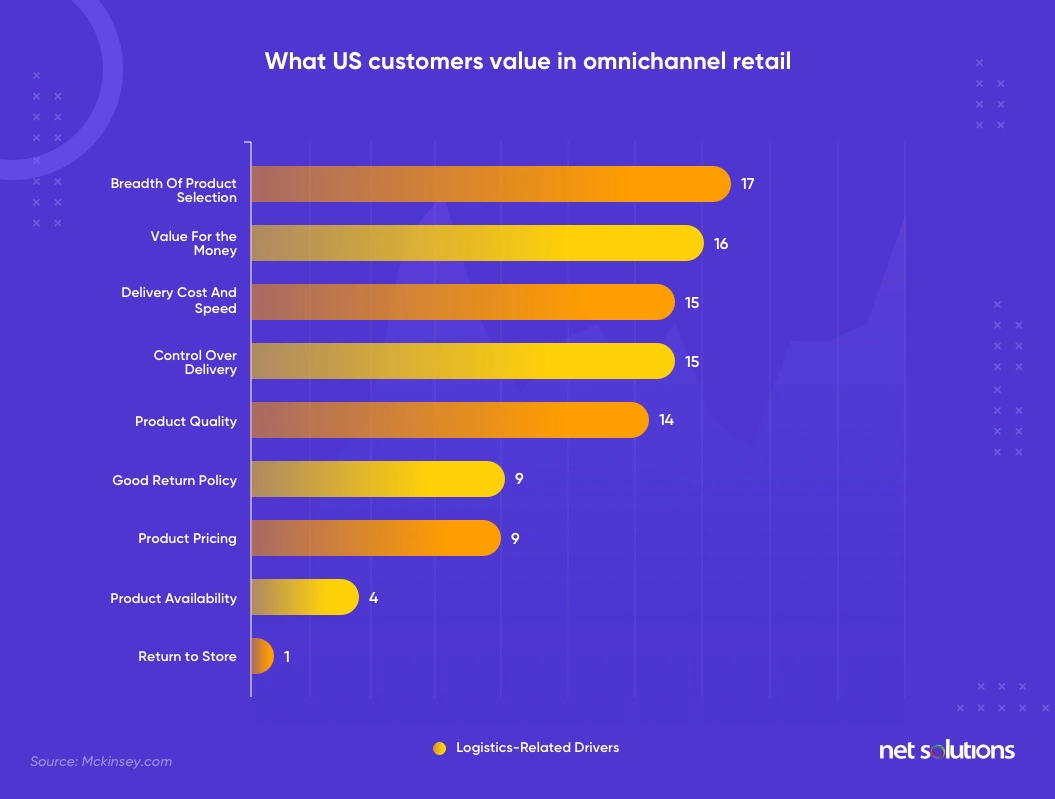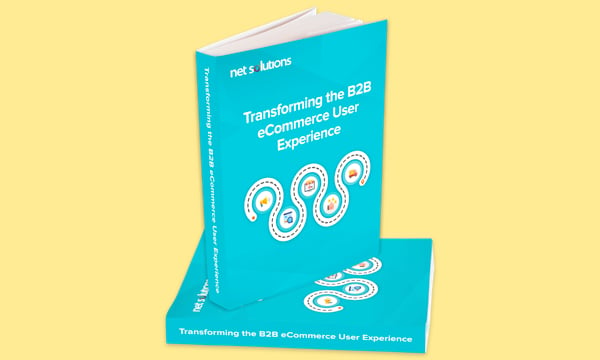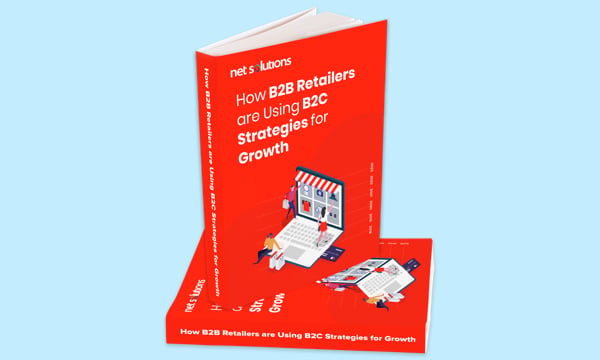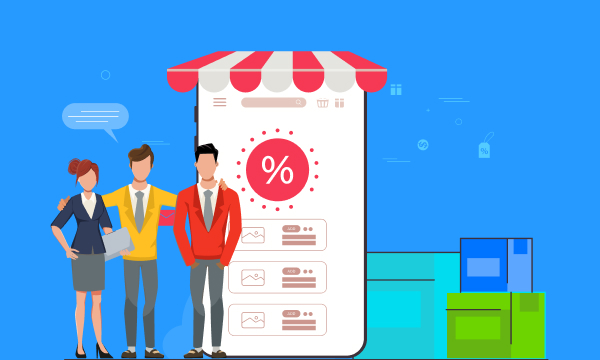What started as a crisis response for eCommerce in 2020 has become the new normal, with enormous implications for how buyers and sellers will do business. While we could have never foreseen the rippling impact of this shift, they are making themselves apparent now.
In 2020, the global B2B eCommerce market was worth USD 6.64 trillion, with an expected compound annual growth rate (CAGR) of 18.7% from 2021 to 2028.
Following the suit, we saw several trends establishing a solid foothold and making their way into B2B eCommerce in 2025. Trends like eCommerce Personalization, Mobile Wallets, and omnichannel selling achieved popularity. 2025 is anticipated to push the envelope further in B2B eCommerce with new trends.
Not only is the B2B marketplace gradually increasing its online presence, but it is doing so by mirroring some key B2C eCommerce strategies.
These trends will shape the B2B Commerce environment and assist business leaders in delivering better, seamless experiences to their potential and existing customers.
10 B2B eCommerce Trends that will Steer 2025
On the one hand, the pandemic has resulted in the closure of many physical stores. On the other hand, B2B companies expect a surge in online sales, pushing them to overhaul their marketing messages.
Today’s rapid adoption of online channels necessitates that B2B commerce companies leverage full capabilities and offerings of platforms to attract, delight, and serve their customers. This warrants having in place strategies to prioritize differentiated digital experiences. Ecommerce is no longer confined to building an emergency buffer to what is happening but delivering ultimate long-term value to customers when the world eventually returns to normal.
This article identifies critical B2B eCommerce trends in 2025, exploring their benefits, challenges, and impact on the B2B landscape.
1. Omnichannel Experience
B2B buyers aren’t just moving to omnichannel. They’ve arrived. Purchasers have shown they want them all given the choice of in-person, remote, and e-Commerce channels.
Customers are the real kings of today’s digital marketplace. They have access to endless information and are surrounded by varied shopping choices, both online and offline. Customer experience is crucial for B2B companies like never before.
Attracting and engaging customers is more competitive than ever as they use various devices and channels every day. Providing a seamless and consistent omnichannel experience is the real game-changer in today’s Darwinian B2B eCommerce landscape.
If you haven’t hopped on the bandwagon already, it’s time to make omnichannel an integral part of your eCommerce strategy. This B2B eCommerce solution ensures consistency across all touchpoints. It also helps customers navigate freely over the website and other channels without losing context when planning to buy a product.
2. Social Commerce
30% of all internet users in the United States complete purchases through social media, compared to 50% of users in China. The attribute of promoting and selling products through social media channels, which keeps your customers hooked to your brand, was a significant game-changer in 2023. Therefore it makes more sense to understand why Social commerce sales will probably triple by 2025. B2B businesses can directly set up their eCommerce store on Facebook, Instagram, or Pinterest.
Here’s an excellent example from the wholesale book retailer Bulk Bookstore:
Buying and selling are no longer restricted to dedicated websites. Businesses can sell their products on social media platforms that best suit their niche without jeopardizing the overall customer experience they want to provide.
3. Digital Supply Chain Management
The COVID-19 pandemic affected global supply chains by exposing most B2B eCommerce companies’ loopholes, especially the ones whose supply chains are highly dependent on China to fulfill their needs for finished products.
Hence, more than 60% of B2B eCommerce companies choose to reduce their reliance on specific countries such as China and increase their existing centers’ capacity.
B2B leaders across all industries must focus on integrating their foundational supply chain capabilities with trending digital strategies. In this way, they can defend against global supply chain abnormalities and remain competitive. In our experience, affected B2B eCommerce companies should consider building a robust digital supply chain framework. It would ensure they can successfully navigate challenges like inventory management and delivering a personalized customer experience.
4. Personalized Customer Experience
Customer segmentation by demographic data will no longer be helpful. If you wish to take your customers’ experience to the next level of personalization, you need to dig into their behavioral and attitudinal attributes. At the same time, this will help you track how, when, where, and why consumers shop; it also enables you to deliver tailored, seamless, end-to-end experiences.
To boost customer loyalty, you must build some customer-centric moments, make them remember you for a long time, and increase your brand loyalty. Just have the corresponding Return on Experience (ROX) measurements to track this loyalty and ensure your experiences produce the desired effect.

We respect your privacy. Your information is safe.
5. Mobile Wallets
It is a known fact that B2B customers are consumers too. Even B2B buyers demand a similar seamless digital experience delivered by their favorite B2C brands in today’s crowded market. B2B eCommerce brands that fail to meet such digital demands will quickly lose to competitors.
All my marketing strategies failed when one of my potential buyers abandoned her shopping cart because of the unavailability of a checkout option through the mobile wallet. Pranav Jain, Head of Business Development, Adinath Dyeing Finishing Mills
That’s why B2B needs to transform digitally, and it’s happening now.
6. Companies lean into sustainability
As sustainability forays into the center of everything a business does, more companies need to adopt a similar stance to create initiatives around sustainability. And while the sustainable goals are excellent for the environment, they are proven equally beneficial for businesses. Studies indicate eco-friendly businesses attract 4.3 times more faithful customers than others, and their conversion rates grow up to 20%. Sustainable packaging is one of the finest ways to adopt the eco-friendly approach and involve your customers directly.
The eCommerce B2B brand Avery Dennison—a label manufacturer— excellently carried over the tactic in their business to assure a satisfying experience for their customers. The brands purchasing from them are satisfied to buy from a more eco-friendly brand with every purchase and product arrival.
However, the approach can be different according to your customer service offerings. Whether it’s the product material, packaging, reducing energy consumption in manufacturing, etc., it’s significant for you to find a sustainable and environment-friendly solution for the future.
7. Automated B2B transactions
Automation is vital for a colossal business segment like B2B to ensure a smoother customer experience and enrich your online marketplace’s reputation.
eCommerce trends here will enable more automation, including automated accounts payable, accounts receivable, reordering and fulfillment. Some key reasons for embracing B2B payment automation tools-
- Saving Business Resources And Time Through Streamlined Data Entry
- Ensuring Frictionless Payment Automation
- Enhanced Control On Payment Processing
While doing business with other brands and companies, leverage the latest technologies to work their most significant pain points.
8. Augmented reality to visualize purchases
“The pandemic forced more companies and consumers to turn to eCommerce, and as companies looked to set themselves apart, a major emerging trend has been AR marketing. Incorporating augmented reality into an existing eCommerce platform has proven to double conversion rates and increase cart size by 60% for online retailers.”
Ashley Crowder, co-founder and CEO of AR company VNTANA
Augmented Reality (AR) is a significant part of the bigger picture, and by 2025, researchers expect 25% of enterprises to launch AR integrations, while the other 70% will start exercising it. With AR, customers aren’t required to wonder how the new couch will suit their living room ambiance. Using smart devices can help in experiencing their living room with the new addition. Similarly, flooring, workspace artwork, or clothing items encourage brands to try on a product virtually.
To productively channel their time and efforts, business owners will prefer AR experiences to save themselves from unwanted hazards. Therefore, if you haven’t added AR to your concurrent list for 2025 and after, it’s time to make crucial alterations.
9. Demand for Fast B2B Order Fulfillment
The urgency for fast yet efficient fulfillment processes is imperative as more B2B businesses cross the digital threshold. In a post-Amazon world, millennials drive this demand, with 73% involved in the B2B buying process today.
Growing customer expectations expand how businesses can appeal to their buyers by streamlining order management software’s fulfillment processes. This software can help a B2B manage orders across different sales platforms, centralize information, and reduce supply chain complexity.
B2Bs have stunned the entire commerce marketplace by adopting new technologies. They’re integrating mobile wallets, one of the critical B2B eCommerce trends, into their eCommerce business model.
10. Brand strategy in the Metaverse
If you’re keeping up with the significant transitions of 2023, you must have come across Mark Zuckerberg’s ambitious goal to pioneer the Metaverse and his company’s rebranding itself as “Meta.”
What is Metaverse?
If we consider the internet two-dimensional- with text and images appearing on a flat screen, consider the Metaverse as three-dimensional with multi-sensory (including touch)— which clearly, is the next stage for internet advancement.
Businesses in the forthcoming years have to adapt themselves to platforms that engage their target audiences more. The Metaverse is the online space where humans interact with avatars, and it’s the virtual extension of our physical world. However, it’s not new: gaming platforms like Roblox and Fortnite have surfaced in the meta-universe already.
What does this have to do with businesses?
Creating your brand’s space in the Metaverse has to be at the top of your to-do list to keep up with the ever-growing digital channels.
There are (and will be as the Metaverse and its access expands) several ways B2B online retailers can benefit from this upcoming trend. By creating online spaces for companies to try out products for their existing and new customers before buying, brands can quickly increase sales in their B2B marketplaces.
Frequently Asked Questions
1. How big is the B2B eCommerce market?
According to Grand View Research, the global B2B eCommerce market size was worth USD 6,883.47 billion in 2021. The number is projected to expand at a compound annual growth rate (CAGR) of 19.7% from 2022 to 2030.
2. How does B2B eCommerce make money?
B2B eCommerce platforms make money in four ways:
- By facilitating commerce (buying and selling commission)
- Offering finance and credit
- By charging for logistics services
- Supplying value-added services like advertising and analytics
3. What are the four types of B2B buyers?
Following are four types of buyers in the B2B markets:
- Producers: Companies that purchase goods and services that they transform into other products. Manufacturers and service providers like Procter & Gamble, General Motors, McDonald’s, and Dell are an example.
- Resellers: Companies that sell goods and services produced by other firms without materially changing them. Wholesalers, brokers, and retailers like Walmart and Target are an example.
- Governments: Governments are the biggest purchaser of goods and services in the world.
- Institutions: Institutions are nonprofit organizations that buy a huge quantity of products and services.

















